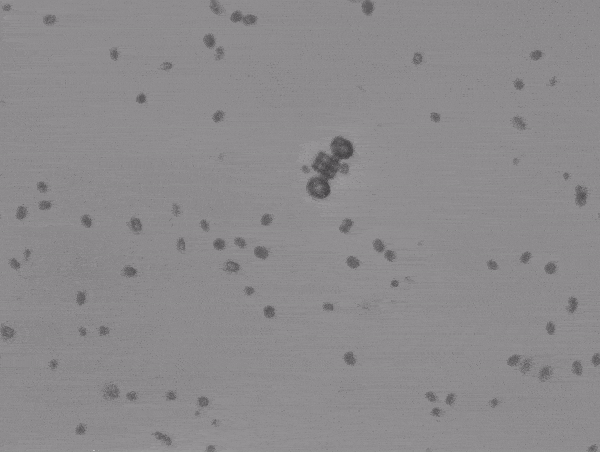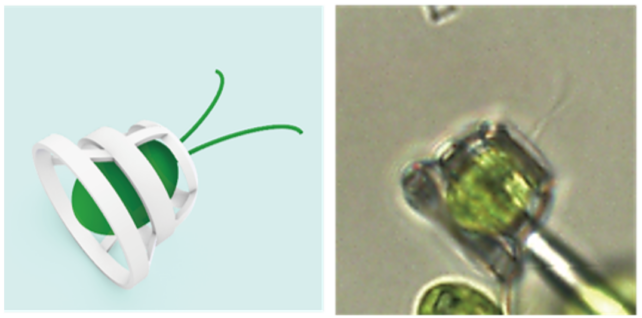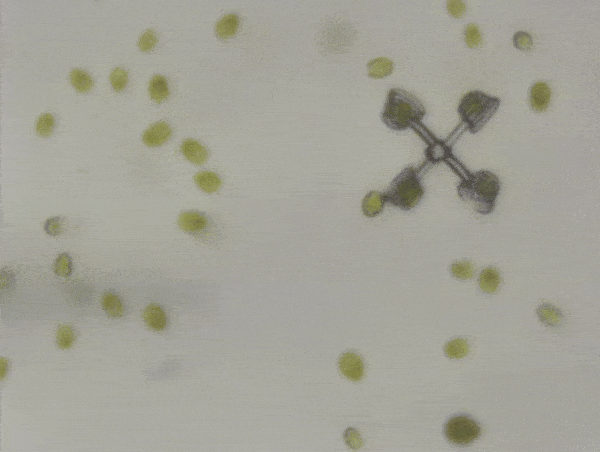In 1959, the famous physicist Richard Feynman envisioned a future in which tiny robots would swim through our bloodstream, repairing or dispensing drugs on the go. .
Sixty-five years later, scientists are getting closer to that truth.
Engineers at the University of Tokyo have now found a way to power tiny invisible structures without the need for an external power source.
The solution? A group of free-moving, single-celled organisms connected to a ‘car’ like miniature horses.

The research wasn’t just about looking for beauty, although it looks as good as it sounds. One of the problems with the ‘microbots’ developed so far is that when they are too small, fluids such as blood can take on the appearance of molasses.
This makes it difficult for the bot to move, which is why scientists have been trying for years now to create small engines powerful enough to easily move such structures.
Using the fast swimming ability of green algae Chlamydomonas reinhardtiiJapanese engineers have developed a unique solution.
Each cell of C. reinhardtii it is only 10 micrometers in diameter, which is a third of the size of the Benchy tugboat – the smallest ship in the world, printed in 3D in 2020.
Together, however, they can pull off tiny machines five times their individual size – “opening up a whole new realm of possibilities for the development of sophisticated micromachines”, the machine’s designers we.
The length, which is considered safe for human consumption, is carried by two flagella, which move each unit forward in the same way as a breast.
Trapped in a basket made of a specially designed bridle, the cell’s flag protrudes forward, allowing it to pull the rest of the vehicle behind while rowing.

Unlike other micromotors that scientists have developed – which often rely on external energy sources such as gravity or electricity – living motors such as C. reinhardtii it can drive itself.
Lead author Haruka Oda and her colleagues designed two different 3D-printed plastic vehicles for the algae to drive, each between 50 to 60 microns in diameter. width. To put that into perspective, the average human hair is about 100 microns thick.
One of the micromachines is called “Scooter”. It has two baskets for catching two algae cells, both of which face the same direction and are connected to the rear ‘warrior’.
Without a promise, C. reinhardtii take their positions in each staff room.
Investigators were surprised to find the scooter not moving properly, even though every basket was there. Instead, it rotated and changed in complex ways. It even does 15 back-flips and 10 rolling movements.

Another version of the car, called the “Rotator”, fared better. It was made of four baskets, all pointed in the same direction and connected by spokes to form a wheel-like structure.
With one algal cell occupying each of the four baskets, this structure “spins” at an average speed of 20 to 40 micrometers per second, similar to a very small carnival ride.

C. reinhardtii it can reach speeds of 100 micrometers per second when unloaded, so researchers are now trying to see if they can make these tiny machines move faster and more precisely.
The Rotator, which was only 56 micrometers in size, is five times larger than another previously designed microvehicle created in 2017 for use by autonomous organisms. However, unlike algae, the speed of these bacteria had to be controlled by a special light modulator.
“The methods presented here are not only useful for detecting the movements of individual algae, but also for creating a device that can analyze their coordinated movements under difficult conditions,” says Shoji Takeuchi, who was in charge of the project.
“These methods have the potential to evolve in the future into technologies that can be used for environmental monitoring in aquatic environments, and for biological transport, such as transport of waste or nutrients in water. “
One day, these research methods may even bring about Feynman’s dream of a microbot that transports ‘small cargo’, such as medicine, in a fluid environment, such as blood, carried by life itself.
The lesson was published in Small.
#Small #Cars #Driven #Imagine
